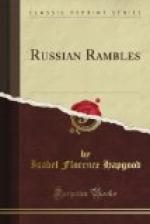The boatmen, who have trundled all day long their quaint little barrows over the narrow iron rails into the spacious inner courtyards of the houses on the quay, and have piled up their wood for winter fuel, or loaded it into the carts for less accessible buildings, now sit on the stern of their barks, over their coarse food,—sour black bread, boiled buckwheat groats, and salted cucumbers,—doffing their hats and crossing themselves reverently before and after their simple meal, and chatting until the red glow of sunset in the north flickers up to the zenith in waves of sea-green, lilac, and amber, and descends again in the north, at the pearl pink of dawn. Sleep is a lost art with these men, as with all classes of people, during those nerve-destroying “white nights.” When all the silvery satin of the birch logs has been removed from their capacious holds, these primitive barks will be unpegged, and the cheap “bark-wood,” riddled with holes as by a mitrailleuse, will be used for poor structures on the outskirts of the town.
On the upper shore of this river, second only to the Neva in its perennial fascination, and facing on the Prospekt, stands the Anitchkoff Palace, on the site of a former lumber-yard, which was purchased by the Empress Elizabeth, when she commissioned her favorite architect, Rastrelli, to erect for Count Razumovsky a palace in that rococo style which he used in so many palaces and churches during her reign and that of Katherine II.,—the rococo style being, by the way, quite the most unsuited discoverable for Russian churches.
Count Alexei Grigorevitch Razumovsky was the Empress Elizabeth’s husband, the uneducated but handsome son of a plain Kazak from Little Russia, who attracted the attention of Elizaveta Petrovna as his sweet voice rang out in the imperial choir, at mass, in her palace church. When the palace was completed, in 1757, it did not differ materially from its present appearance, as a painting in the Winter Palace shows, except that its colonnade, now inclosed for the Imperial Chancellery and offices, then abutted directly on the Fontanka. It has had a very varied ownership, with some curious features in that connection which remind one of a gigantic game of ball between Katherine II. and Prince Potemkin. Count Razumovsky did not live in it until after the Empress Elizabeth’s death, in 1762. After his own death, his brother sold it to the state, and Katherine II. presented it to Prince Potemkin, who promptly resold it to a wealthy merchant-contractor in the commissariat department of the army, who in turn sold it to Katherine II., who gave it once more to Potemkin. The prince never lived here, but gave sumptuous garden parties in the vast park, which is now in great part built over, and sold it back to the state again in 1794. It was first occupied by royalty in 1809, when the Emperor Alexander I. settled his sister here, with her first husband,—that Prince of Oldenburg whose territory in Germany Napoleon I. so summarily annexed a few years later, thereby converting the Oldenburgs permanently into Russian princes.




